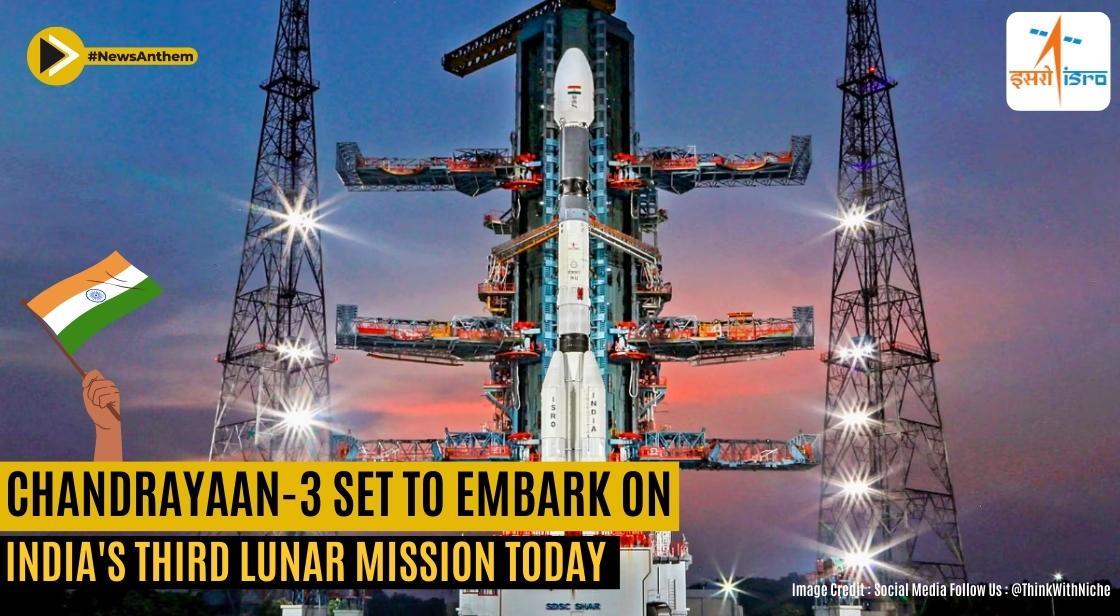Chandrayaan-3 Set to Embark on India's Third Lunar Mission Today

News Synopsis
Countdown Begins for Chandrayaan-3's Third Moon Mission
The Indian Space Research Organisation (ISRO) has initiated the 25-hour 30-minute countdown for the launch of Chandrayaan-3, India's highly anticipated third moon mission. This lunar expedition follows the Chandrayaan-2 mission in 2019, with the objective of achieving a soft landing on the moon's surface.
A successful mission will establish India's position alongside the United States, China, and the former Soviet Union as one of the select few nations to accomplish this remarkable feat in space exploration.
Advancing Inter-Planetary Missions with Chandrayaan-3
Chandrayaan-3 marks India's continued progress in lunar exploration, comprising an indigenous lander module (LM), propulsion module (PM), and a rover. The mission's primary focus is on developing and demonstrating new technologies necessary for future inter-planetary missions.
By venturing into the lunar south pole, Chandrayaan-3 aims to unlock the mysteries of this unique geological region and shed light on its significance.
Significance of Chandrayaan-3's Success
The successful completion of Chandrayaan-3 will position it as the surface mission closest to the lunar south pole, offering unprecedented access to study its geological characteristics and investigate permanently shadowed areas. The mission's scientific payloads will facilitate comprehensive research, and an instrument on the propulsion module will examine signs of life on Earth, aiding scientists in their search for similar signs on other planets beyond our solar system.
Chandrayaan-1's Contribution and Global Collaboration
The Chandrayaan-1 mission, ISRO's inaugural attempt at lunar exploration, made significant contributions to the scientific community. It confirmed the presence of water molecules on the moon's surface, a discovery that holds crucial implications for future manned missions. Chandrayaan-1 received international recognition and acclaim, highlighting the collaborative nature of lunar missions, which foster scientific exchange and strengthen global camaraderie.
The Importance of Lunar Missions
Lunar missions, such as Chandrayaan-3, play a vital role in international cooperation and knowledge sharing. Many countries actively participate in these missions, contributing to collective scientific advancements.
The exploration of the moon's south-polar region holds immense potential for international collaboration, as the area contains shadowed sites with hydrogen, water, ice, and possibly primordial material.
Studying our celestial neighbor contributes to a deeper understanding of the origins of the Solar System and the cosmos itself.
Success Stories of Soft Landings
Despite the challenges involved, only three countries have successfully achieved soft landings on the moon. The United States accomplished this milestone with Surveyor 1 in 1966, while China achieved success with Chang'e 3 on its first attempt. The Soviet Union also achieved a soft landing with Luna 9 shortly before Surveyor 1. These examples demonstrate the significance of soft-landing missions and the pioneering spirit driving space exploration.
Enhancements and Upgrades in Chandrayaan-3
Chandrayaan-3 distinguishes itself from its predecessors with improvements to the landing process. The rocket will place the payload in an elliptical orbit around the Earth, after which a propulsion module will take over and guide the lander into a circular orbit around the moon. ISRO has made enhancements to the lander's legs, lowered its minimum thrust, increased power availability, and upgraded the landing sequence, all designed to enhance the mission's chances of success.
Latest facts about the Chandrayaan-3 mission:
-
The launch of Chandrayaan-3 is scheduled for today, July 14, 2023, at 2:35 p.m. IST from the Satish Dhawan Space Centre in Sriharikota, Andhra Pradesh.
-
The mission will be carried by a GSLV Mk-III rocket, which is the most powerful rocket in India's fleet.
-
The lander, named Vikram, will be carrying the rover, Pragyan. The rover will be tasked with exploring the lunar surface and collecting data.
-
The success of Chandrayaan-3 would make India the fourth country to soft-land on the moon, after the United States, the former Soviet Union, and China.
-
The lunar south pole is a particularly interesting region for scientists because it is thought to be home to water ice. Water ice is a valuable resource for future human exploration of the moon, as it could be used for drinking, fuel, and other purposes.
-
Chandrayaan-3 is a follow-up mission to Chandrayaan-2, which was launched in 2019. The Chandrayaan-2 mission was not able to soft-land on the moon, but it did make a number of important discoveries, including the presence of water molecules on the moon.
-
The success of Chandrayaan-3 would be a major achievement for India and would demonstrate the country's growing capabilities in space exploration.
As Chandrayaan-3 prepares to embark on its lunar mission, the anticipation and excitement surrounding India's scientific endeavors reach new heights.
This mission not only reinforces India's commitment to space exploration but also brings the nation closer to unraveling the mysteries of the moon and expanding humanity's understanding of the universe.
You May Like









